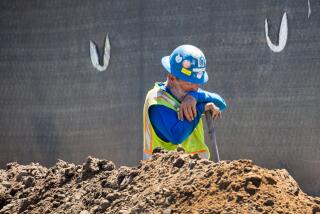Hot Tips for When It’s Warm
- Share via
Noel Coward said it: “Mad dogs and Englishmen go out in the noonday sun.” Medical experts put it a little less poetically but just as emphatically. When it’s hot: Stay indoors, drink plenty of fluids and exercise with caution.
As the thermometer soars, the very young and the elderly are particularly susceptible to heat-induced illness. “So far we’re only seeing heat exhaustion,” said Dr. Ken Corre, medical director of emergency services at Simi Valley Hospital, “but there’s always the potential for heatstroke.”
How to know if you’re in danger? Symptoms of heat exhaustion, Corre said, include generalized malaise, weakness, difficulty concentrating, thirst, dryness of the mouth and “just not feeling normal.”
The more severe and “very lethal” heatstroke, Corre said, “can look for all the world like a regular stroke. There can be paralysis, altered mental state . . . they can be comatose. . . . Fortunately, it’s a pretty rare condition,” one that strikes the young and old most frequently.
Not rare at all, however, are nasty sunburns, heat cramps, watery eyes and the blahs, all of which can be minimized by taking a few precautions.
To avoid dehydration, Tamar Apelian, a registered dietitian at Glendale Adventist Medical Center, advises eliminating alcohol and caffeine. She doesn’t rule out a cup of coffee in the morning, but cautions that coffee should not replace nourishing fluids such as juices throughout the day.
Apelian recommends a well-balanced diet and frequent small meals. “Very heavy meals can slow down the rate at which fluids leave the stomach to become available for replacing sweat losses,” she says. Because high-protein foods are very low in water, she adds, they should be eaten sparingly while fruits and vegetables, high in water, should be increased.
Not all the weather news is bad, though. Bruce Selik, a meteorologist with the South Coast Air Quality Management District, points out that smog levels actually dip on an extremely hot day. At 90 degrees or higher, he said, “the inversion layer breaks and then the smoggy air down below can mix and become diluted with the air that was above the inversion.”
Senior citizens are particularly susceptible to heat-related disorders. Dr. Loren G. Lipson, head of geriatrics at the USC School of Medicine, said: “Many seniors have cognitive impairment. They can be forgetful. They may have Alzheimer’s disease and so don’t always think out what it is to be in the hot weather” and react appropriately.
Further, Lipson said, many have a condition called autonomic neuropathy, one effect of which is to make it difficult for them to sense temperature changes. “It’s possible they may not realize how hot the environment is around them.”
Even healthy senior citizens have an added risk of dehydration, Lipson said, because they tend not to drink enough fluids anyway. “You don’t have the same thirst drives. That adds to the danger of being out in the hot sun.”
Because they do not go to an air-conditioned workplace, and many do not have air-conditioned homes or cannot afford the utility bill, there is an added risk. Lipson advised: Open the windows, turn on the fan and drink lots of fluids--hot or cold.
*
Children are also susceptible to extreme heat. Dr. Alan Nager, head of emergency medicine at Childrens Hospital in Los Angeles, said: “When kids go out in the sun they need to be well protected--sunscreen with an SPF of at least 15, applied roughly 20 to 30 minutes prior to going outside and every hour after that. If a child plays in water or has contact with a grassy surface, it may rub off” and should be reapplied.
Avoiding the period when the sun is hottest--from 10 a.m. to 3 p.m.--is advisable, he said, and “it’s always a good idea to wear a hat or visor and sunglasses--for children who can keep sunglasses on.”
Dr. A. Paul Kelly, chairman of the division of dermatology at Martin Luther King Jr./Drew Medical Center, has a few words of advice about the sun: “Basically, try to stay out of it.”
Kelly notes that it isn’t only the fair-skinned who need protection from ultraviolet rays, although they are much more susceptible to skin cancer and malignant melanoma than those with darker skin. Everybody needs sunscreen, he emphasized, if only to protect from the aging effects of the sun.
What strength? “An SPF of 15 gives you 95% protection,” he says. “You can get up to SPF 50, but it doesn’t seem to make that much difference.” He also recommends special hats and clothing that block out the sun.
Swimmers, he adds, are particularly susceptible to burning. “You’re getting sun from overhead and the reflection from the water, so you get a double dose.”
Exercise may need to be reduced or modified, said Dr. John DiFiori, assistant professor of medicine at UCLA and assistant team physician for intercollegiate athletics. He suggests that people avoid outdoor exercise during the middle of the day to avoid heat-related illnesses.
A person who usually jogs two miles might want to cut back to a mile, he suggested, or “if you normally jog at an eight-minute-per-mile pace, you might need to slow down a little bit.”
Highly trained athletes are equally susceptible to heat, he says, especially when--as now--the hot weather has come on rather rapidly. “It does take time to acclimate.”
Never exercise, he cautioned, without first drinking water or an electrolyte drink, taking replacement drinks during exercise and rehydrating after exercise.
“If you really have the urge to exercise,’ said Dr. Wally Ghurabi, medical director of the emergency center at Santa Monica-UCLA Medical Center, “do it indoors where it’s air-conditioned. And drink a lot of water or juice, even if you’re not thirsty. If you wait until you’re thirsty, you’ve waited too long.”
For those who insist on taking their exercise outdoors, he suggested starting at 4 a.m. or 5 a.m. and finishing no later than 7 a.m.


